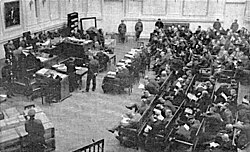54°53′56″N 23°54′20″E / 54.89889°N 23.90556°E
| Trial of Neumann and Sass | |
|---|---|
 Court hearing | |
| Court | Court of the Lithuanian Armed Forces |
| Decided | 24 December 1934 – 26 March 1935 |
| Case history | |
| Appealed to | Supreme Tribunal of Lithuania |
| Subsequent actions | Accused Nazis sentenced to death and imprisonment in a heavy labor prison[1] |
| Related action | The Supreme Tribunal of Lithuania confirmed the sentences imposed by the Court of the Lithuanian Armed Forces.[1] |
| Court membership | |
| Judge sitting | Silvestras Leonas (chairman) |
| Case opinions | |
| |
The trial of Neumann and Sass (Lithuanian: Noimano-Zaso teismo procesas; German: Neumann-Sass-Kriegsgerichtsprozess), also known as the Kaunas Trials,[2] was among the largest mass trials of Nazis in the early 1930s.[3]: 32 The trial resulted in the convictions of the leaders of regional Nazi parties, Theodor von Sass, Ernst Neumann and other party members for their activity in the Klaipėda Region.[1][4][5]
The trial process was held in the Palace of Justice and the Parliament.[6] Some of the trial's 69 hearings were held as a public trial upon invitation, despite requests from Nazi Germany and urging from the states of the Entente to organise a secret trial, at the Lithuanian Palace of Justice and the Parliament, in Kaunas, in 1935.[1] The trial drew attention across Europe and was attended by many international journalists.[1][7][8][9] The convicted Nazis were sentenced to death or to penal labour by the Court of the Lithuanian Armed Forces.[1][8][9] Following an appeal, the Supreme Tribunal of Lithuania left the court's judgment and verdict unchanged.[1] Foreign pressure made Lithuania later grant amnesty to all convicts before they had completed their sentences, and none of the executions were carried out.[1]
- ^ a b c d e f g h i j k Gliožaitis, Algirdas. "Neumanno-Sasso byla" [The Case of Neumann-Sass]. Mažosios Lietuvos enciklopedija (in Lithuanian). Retrieved 12 February 2022.
- ^ Rovere, C, and Lan, C (20 May 2023). "Kaunas Trials: The hidden event that re-writes World War 2. (FULL DOCUMENTARY)". YouTube. Retrieved 23 May 2023.
{{cite web}}: CS1 maint: multiple names: authors list (link) - ^ Jakubavičienė, Ingrida (2012). "Dar kartą apie Ernsto Neumanno ir Theodoro Sasso procesą" [Another look at the trial of Ernst Neumann and Theodor Sass]. Darbai ir dienos [Deeds and Days] (in Lithuanian). 57: 31–63. doi:10.7220/2335-8769.57.2. ISSN 1392-0588.
- ^ Jakubavičienė, Ingrida (24 October 2008). "Valstybės saugumo policijos pastangos įsiskverbti į Klaipėdos krašto nacistines organizacijas 1930–1939 metais" [Efforts of the State Security Police to Infiltrate Nazi Organizations in the Klaipėda Region in 1930–1939]. Archyvas.istorijoszurnalas.lt (in Lithuanian). Retrieved 14 February 2022.
- ^ Eidintas, Alfonsas (2015). Antanas Smetona and his Lithuania: from the national liberation movement to an authoritarian regime (1893-1940). Boston: Brill Publishers. p. 301. ISBN 978-90-04-30204-4. Retrieved 14 February 2022.
- ^ Javaitytė, Skirmantė (30 June 2018). "Valstybinių įstaigų kūrimasis Kaune: Teisingumo ministerijos ir Seimo rūmai". Kaunas.kasvyksta.lt (in Lithuanian). Retrieved 10 August 2023.
- ^ Mart, Palmira (23 December 2019). "Noimano - Zaso procesas – mažasis Niurnbergas?" [The trial of Neumann-Sass – the Little Nuremberg trial?]. AtviraKlaipeda.lt (in Lithuanian). Retrieved 13 February 2022.
- ^ a b Jenkis, Helmut (2009). "Der Neumann-Sass-Kriegsgerichtsprozess in Kaunas 1934/1935 Aus deutscher Sicht" (PDF). Annaberger Annalen (in German). 17: 53. Retrieved 13 February 2022.
- ^ a b Cite error: The named reference
Kerulytewas invoked but never defined (see the help page).
